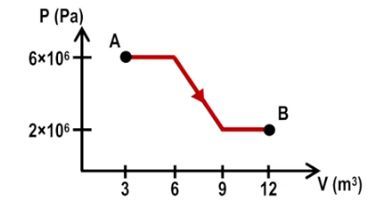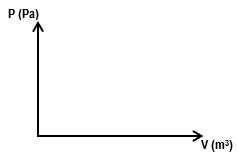Hey, everyone. So in the last couple of videos, we saw how to calculate the work done in thermodynamic processes, whether they were straight lines like horizontal or slanted lines. Now, in some problems, you're going to have more than one thermodynamic process. So, I'm going to show you how to calculate the work done when you have multiple processes that a system goes through. For example, let's say that a system goes not only from point A to point B but let's say it also goes from point B to point C, and you want to calculate the total work over the whole process. So let me show you how to do that. Remember that each process, like the one from A to B, creates its own area under the curve, and so that's just an individual work. Let's just say for simplicity this is 100 joules. Now from B to C, that's another process that creates another area, and therefore there's another work and has to be less than 100 because the area is smaller. So let's just call this 80. If I want to calculate the total work, it's just going to be the sum of both of those together. It's basically going to be the total area under the curve. So it's just going to be 100 + 80, and that's just 180 joules. Alright. So that's pretty straightforward. In general, the total work done over multiple thermodynamic processes is just going to be the sum of all the works done in each individual process.
As a general equation, this is going to be \( W_{\text{total}} = W_1 + W_2 + \ldots \) however many individual works you have in that process, alright, in that problem. So in general, what happens is that this was kind of simplistic because we just gave you the works. In a lot of problems, you're not going to be given those works and you're going to have to calculate them. So what happens is in your problems there are four special thermodynamic processes that you're going to see over and over again. So what I want to do is sort of introduce you to those four, and what I want to do in this video is start building out a table. And this table here is going to house all the information and equations that you'll need. We'll keep on building on top of this table in future videos and eventually, you'll have everything you need for these problems. So let's go ahead and check this out here. The two I want to talk about in this video are isobaric and isochoric. The other two we'll talk about later are isothermal and adiabatic. So isobaric, the word iso or the prefix iso just means constant and baric means pressure. You could think of a bar as a unit of pressure. That's something you may remember, but also a barometer is something that measures pressure. So isobaric just means constant pressure. Alright. We actually saw these kinds of problems before. This is whenever you had some constant pressure and you were changing from initial to final volume. Right? It was a straight horizontal line, and we saw that the work equation was \( P \Delta V \). We're next we're going to talk about isochoric processes. As the name implies, this is when you have constant volume. This is basically kind of the opposite of this situation over here. Here you have constant volume, but now you're going to be changing from initial to final pressure. So what this looks like on a PV diagram is it kind of just looks like a straight vertical line like this. So with an isochoric process, that's going to be a straight vertical line. So for this one, you have constant pressure changing volume. For this one, you have constant volume changing pressure. Alright? So now we know what these things look like. Let's go ahead and take a look at our example problem here. So in our example, we have these ideal gas that's in a container here. And basically, the idea is that we want to go from point A to point C, but we're going to take two different paths to get there, A, B, C and then A, D, C in the second part. So let's just jump right into this first part here. We want to calculate the total amount of work done for the ABC path, basically, the top path. So this is a total amount of work done over a multi-step process. So the total work is just going to be the work done for the two processes that make it up. We have one process from A to B, another one from B to C. Now this one here is going to be an isobaric process because it's a straight horizontal line. This one's going to be an isochoric process because it's a straight vertical line. But the total work is just going to be the work done from A to B plus the work done from B to C. We just have to calculate each one of these things and then add them up at the end. So let's go ahead and do that. So the work done from A to B. Now how do we do that? Well, we have to figure out what process it is first. So we take a look from A to B. We said it's an isobaric process. So we can actually just use this equation, \( P \Delta V \). We've seen that force listed right there. Let's go ahead and use it. So this is \( P \times \Delta V \). The pressure for this process is 4,000 and the change in the volume is just from 2 to 5, so this is going to be 3. Notice how we're going to the right here, so that work should be positive, so we don't have to insert a negative sign or anything like that. So this is 4,000 times 3. This is going to be 12,000 joules. So now we just need to figure out what's the work done from B to C. So then we can just add it, and then just figure out the total. Right? So the work done from B to C here. So that's this isochoric process. So the question is can we use this \( P \Delta V \)? Well, hopefully you guys realize that you cannot use this equation because the \( P \) is not going to remain constant. So you can't use this, and the only other way that we can calculate this area or sorry, this work is by calculating the area that's under the curve. So let's try to do that. First, we have to draw the path of the process. We have to draw the shape that's underneath this curve. But if this is a straight vertical line, just a line like this, then you can't draw a square or a rectangle or a triangle or anything like that. The only thing you can draw underneath this straight vertical line is another vertical line. And the area of a vertical line is just 0. It's not a two-dimensional shape. Right? You can't draw a square or anything like that. So that's the big thing here. The area that's done the work that's done by gas in an isochoric process is just equal to 0 because there is no change in volume. That's a super important thing that you need to know. So that means that if this work is equal to 0, then that just means that the total work is just the 12,000 plus 0 and that just gives you 12,000 joules for the whole entire process. So that's how to calculate and solve these kinds of problems here. And that's part A. So let's go ahead and start part B now. You can actually just go ahead and pause the video and see if you can calculate this one yourself. Alright. So in this process here, we're going from A to D and then D to C. This is basically just the reverse of what we did in part A. Basically, you're just switching the order of the processes. So the work done from A to D to C is going to be the work done from A to D, and then the work done from D to C. So in this case, this is the isochoric process. In this case, this is the isobaric process. Now what that means here is remember isochoric processes do no work or have no work. So it means \( \Delta V \) is equal to 0. So really what happens is that the only work is due to the work done from D to C. This is an isobaric process, so we can just use \( P \times \Delta V \). And so all we have to do is just look at the pressure. It's a constant pressure of 2,000, and then the change in the volume is the same. Right? It's the same 3. So this \( \Delta V \) is still equal to 3 and it's positive. And so if you calculate this, this is going to be 6,000 joules. And so therefore, this is the total amount of work done over the ABC process. Alright. So that brings me to my very, very last point here, which is that we went from point A to point C. Our initial and final for the two paths were the same. We just took two different paths to get there. And what we saw was that the work done in each of these processes were not the same. So what happens here is that the work done between two states depends on the path that is taken. This is sometimes called path dependence. Alright, guys. So that's it for this one. Let me know if you have any questions.



